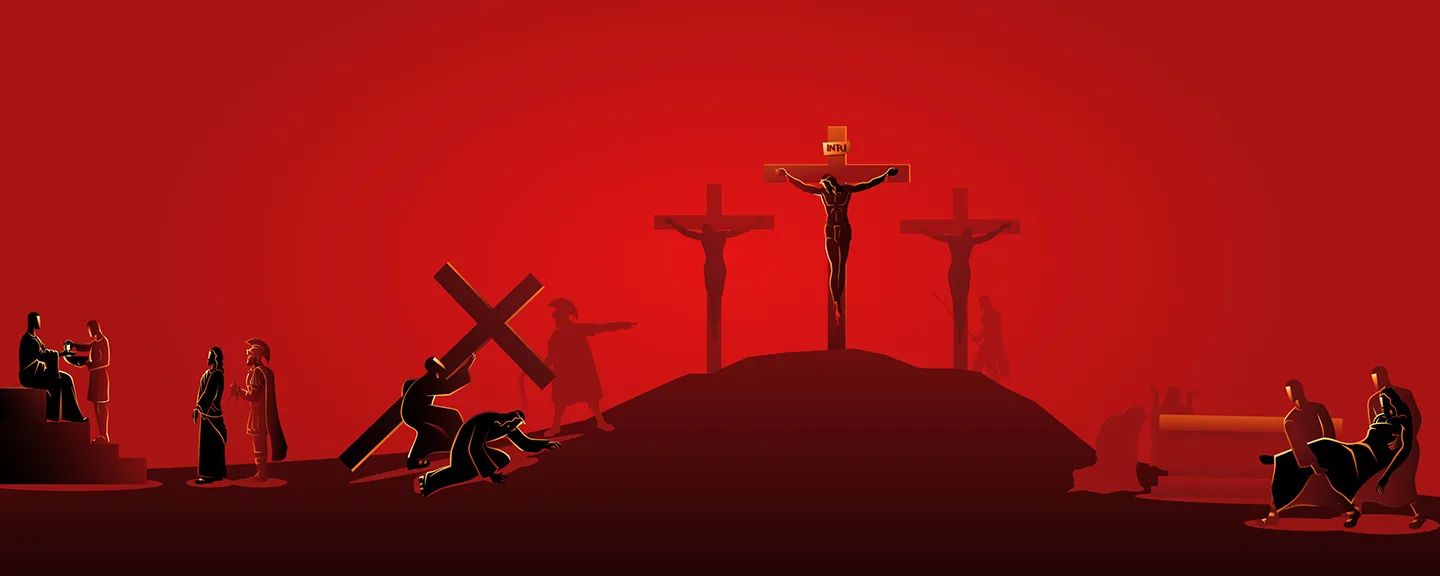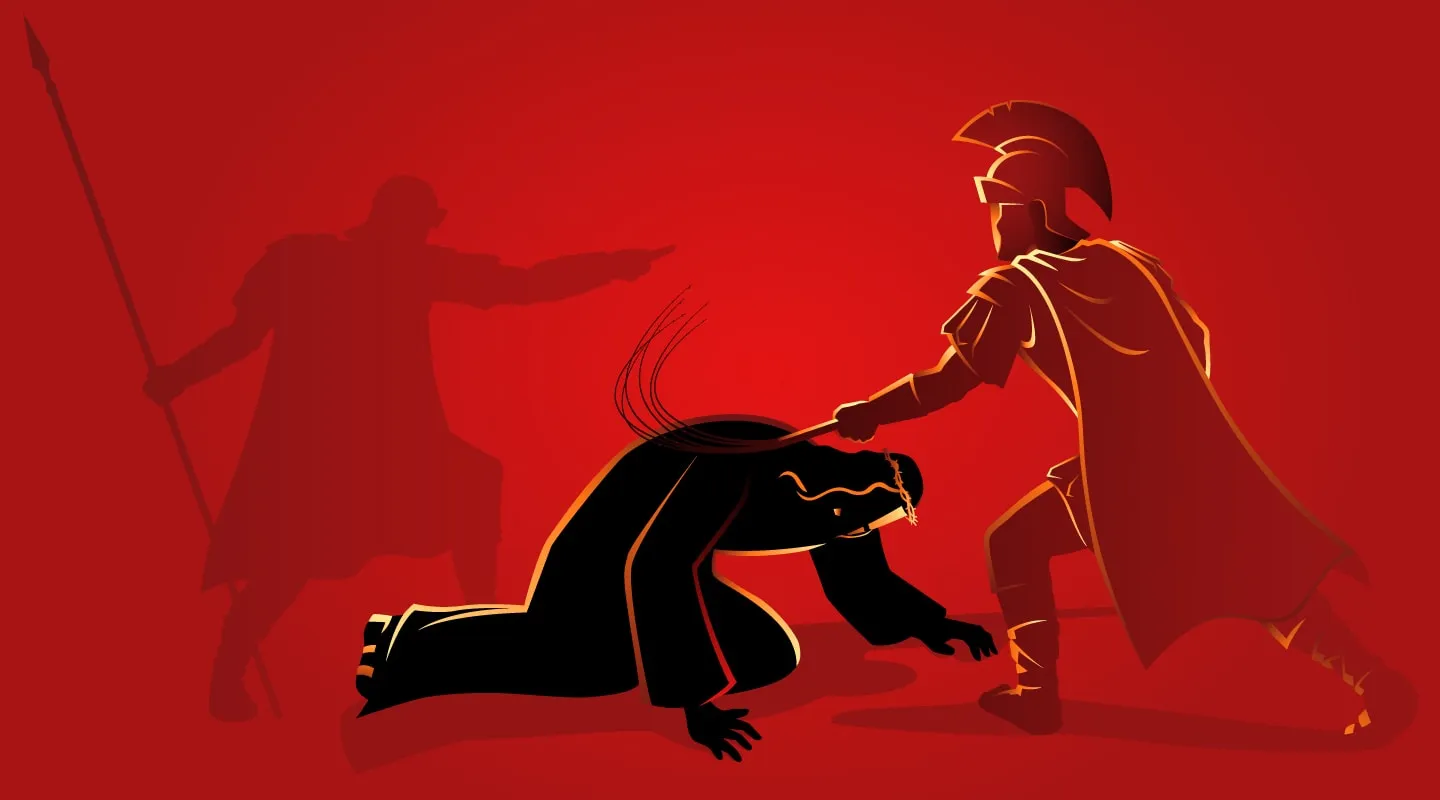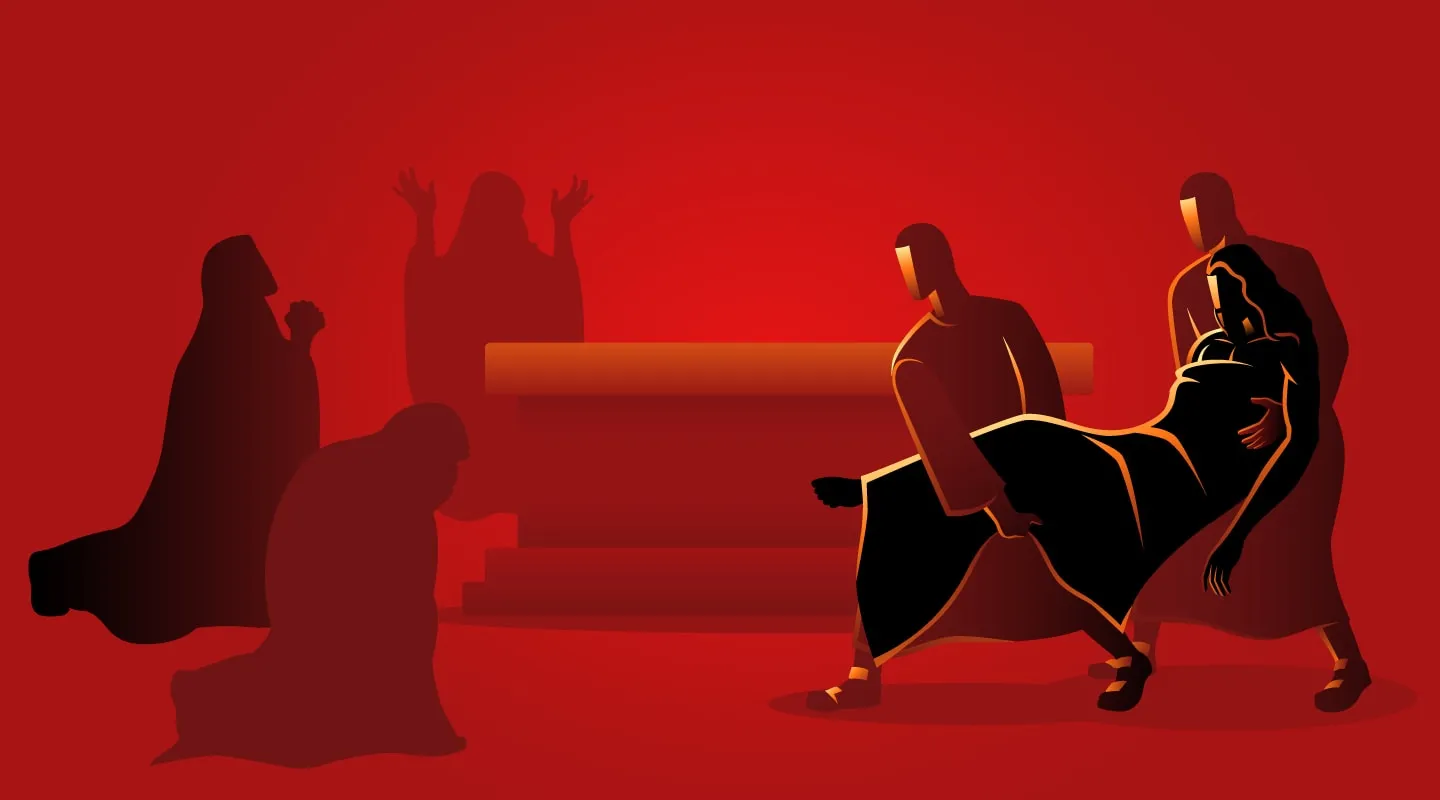- Home
- >
- APU Articles
- >
- News Article
Scriptural Stations of the Cross: A Devotional Reflection on the Science of Jesus’ Crucifixion
March 08, 2019 | Written By Evelyn Allen | Adapted from a lecture Cahleen Shrier, PhD

In the tradition of observing the stations of the cross during Lent, this devotional offers opportunities to meditate on the solemnity of the crucifixion in a tangible and eye-opening way. Although we cannot know with certainty the exact corporeal realities that Jesus faced, the information is medically and biologically accurate. We caution readers, as some of the descriptions are graphic.
Station 1: Jesus in the Garden of Gethsemane
Following the Passover meal and Christ’s Last Supper with His apostles, Jesus takes them to pray at Gethsemane, at the foot of the Mount of Olives in Jerusalem. His heightened anxiety about what is to come is evident when He says, “I am deeply grieved, even to death.” (Matthew 26:38) As He prays in this state of anguish, his sweat becomes like “drops of blood.” (Luke 22:44) In such cases of extreme duress, a rare medical condition known as hematidrosis can occur with the breakdown of small blood vessels near the sweat glands. As blood and sweat mix together, the body is capable of sweating droplets of blood. The skin becomes tender with hematidrosis, marking a worsening of Jesus’ physical condition, in addition to His psychological distress.
Read the Scripture: Matthew 26:36-46, Mark 14:32-42, Luke 22:39-46
Station 2: Jesus, Betrayed by Judas, Is Arrested
As Jesus speaks to the disciples, who have been inattentive and sleeping throughout His fervent praying, Judas arrives. With him is an angry mob accompanied by the elders and chief priests. Judas greets Jesus with a kiss, the signal that He is the one they seek to arrest. Betrayed by Judas, taken into custody, and deserted by the disciples, Jesus’ mental state is no doubt impacted by these events. Betrayal trauma, particularly by someone with whom one is very close, is associated with a host of symptoms, including anxiety, depression, emotional detachment, dissociation, and general physical discomfort.1 Despite this inner turmoil, Jesus accepts His fate saying “... all this has taken place, so that the scriptures of the prophets may be fulfilled.” (Matthew 26:56)
Read the Scripture: Matthew 26:47-56, Mark 14:43-50, Luke 22:47-53, John 18:1-11
Station 3: Jesus Is Condemned by the Sanhedrin
Brought before the council of Caiaphas, the high priest, witnesses testify against Jesus, though their false claims do not hold up. Caiaphas presses Jesus to declare if He is the Messiah and the Son of God, and Jesus responds: “You say that I am.” (Luke 22:70) At this, Jesus is condemned by the Sanhedrin for blasphemy and pronounced deserving of death. The physical assault on Jesus begins, as He is blindfolded, struck repeatedly, and spat upon.
Read the Scripture: Matthew 26:57-68, Mark 14:53-65, Luke 22:66-71, John 18:19-24
Station 4: Jesus Is Denied by Peter
During this time, Peter waits in the courtyard to see what will happen to Jesus. He is soon recognized as one of Jesus’ disciples and approached three separate times to identify himself. Each time, he denies knowing Jesus and grows more agitated. The denials are just as Jesus predicted when He said, “Before the cock crows today, you will deny me three times.” (Luke 22:61) Jesus’ knowledge that this would transpire likely compounded the physiological effects of betrayal by His trusted followers and community.2
Read the Scripture: Matthew 26:69-75, Mark 14:66-72, Luke 22:54-62, John 18:15-18, 25-27
Station 5: Jesus Is Judged by Pilate
Jesus is brought before Pontius Pilate, governor of Judea, who sends Jesus to King Herod to be questioned at length. Herod and his soldiers scorn Jesus before returning Him to Pilate’s court. As Jesus journeys from Pilate to Herod and then back, the trip He undertakes is roughly two and a half miles. He has not slept and has been subject to further mockery and beatings, all worsening His physical condition. Although Pilate cannot find any just cause for execution, the riotous crowds urge him to have Jesus killed. Pilate bends to their will, ultimately releasing the prisoner Barabbas in exchange for Jesus, who he hands over to be crucified.
Read the Scripture: Matthew 27:11-26, Mark 15:1-15, Luke 23:1-25, John 18:28-40

Station 6: Jesus Is Scourged and Crowned with Thorns
As required by Roman law, Pilate orders Jesus to be flogged before crucifixion. The flogging whip is likely made up of leather strips with metal balls in the middle that cause deep bruising upon striking the skin. Sheep bone attached to the ends of the leather strips inflict further injury. Traditionally, an accused person is stripped naked, the flogging covering a large portion of the body from the shoulders to the upper legs.
With each thrash, the embedded shards of bone tear into Jesus’ skin, shredding His flesh, ripping away muscle, and exposing His bone underneath. The skin on Jesus’ back is flayed into ribbons. A great deal of blood is lost during the flogging, and Jesus’ blood pressure falls, sending Him into shock. Jesus also becomes thirsty (John 19:28), His body’s natural response to the significant decrease in blood volume.
Placing a crown of thorns on Jesus’ head and a robe around His body, the Roman soldiers begin beating Jesus in the head (Matthew 27:28-30). While the robe helps His bodily wounds to clot and stems some of the blood loss, the thorns stab the skin around His face and head and more blood pours forth. As the thorns most likely damage Jesus’ trigeminal facial nerve, searing pain shoots down His face and neck. Continuing to belittle and mock Jesus, the soldiers tear the robe from His back, which begins the profuse bleeding again. At this stage, Jesus’ physical condition becomes critical, already on the verge of death.
Read the Scripture: Matthew 27:27-31, Mark 15:15-20, John 19:1-3
Station 7: Jesus Bears the Cross
It was common to force condemned individuals, especially non-Roman citizens, to carry the patibulum or horizontal piece of the cross to their execution site. The cross rubs the open wounds on Jesus’ back, contributing to more blood loss and pain.
Read the Scripture: John 19:16-17

Station 8: Jesus Is Helped by Simon the Cyrenian to Carry the Cross
Jesus’ severe blood loss has restricted the flow of oxygen to His muscles, creating acute muscle fatigue. The weight of the cross further makes balancing difficult for Jesus in His extremely weakened state. While attempting to walk, His muscles cannot compensate for the disruption in balance and He is unable to remain upright.3 Because Jesus is physically unable to carry the cross, Simon of Cyrene is ordered to perform this task.
Read the Scripture: Matthew 27:32, Mark 15:21, Luke 23:26
Station 9: Jesus Meets the Women of Jerusalem
A crowd follows behind on the path to Golgotha, including women weeping and mourning for Jesus, who speaks directly to them. His attention to their presence perhaps bolsters Him somewhat through the intense suffering, as the social support of others has a protective effect on the brain and body. Jesus may have experienced decreased anxiety and lower stress hormones as a result of their support,4 a balm of comfort to His pain.
Read the Scripture: Luke 23:27-31

Station 10: Jesus Is Crucified
Crucifixion was perhaps the harshest punishment imaginable, reserved for the lowest of society—slaves, foreigners, revolutionaries, and vicious criminals. The English word “excruciating” is derived from crucifixion, indicative of this drawn-out form of suffering.5 Jesus’ cross was probably a Tau cross (T-shaped), rather than the Latin cross seen widely today. The vertical portion, or stipes, remain permanently embedded in the ground, while the horizontal patibulum is carried uphill by the accused. On this cross-beam, a sign or titulus notes the occurrence of a trial and the violation—Jesus’ reads, “This is the King of the Jews.” (Luke 23:38)
Jesus is thrown down to be nailed to the patibulum on the ground. Most likely, the nails are driven through Jesus’ wrists, as nails through the hands presumably cannot support the weight of the arms and body without tearing through the flesh. Instead, placement at the wrist bones in the lower part of the hand can support the body, keeping Him nailed to the cross.
The seven- to nine-inch-long nails5 injure or sever the median nerve in the hands upon entry, and near-constant pain tears up Jesus’ arms. With Jesus’ wrists nailed to the patibulum, the guards lift it into place on the stipes, and the full weight of His body wrenches downward, likely dislocating His shoulders and elbows5 (Psalm 22:14), and tearing deeper into His nailed wrists. This distension stretches Jesus’ arms by at least six inches beyond their normal length.
The tops of Jesus’ feet are likely nailed with His knees bent at a near-90-degree angle.6 His ankles support the weight of His body, which shifts down on the nails, though they do not tear through the tissue as with the hands. The nail inflicts nerve damage and subsequent pain.
Read the Scripture: Matthew 27:33-37, Mark 15:22-32, Luke 23:33-38, John 19:18-25
Station 11: Jesus Promises His Kingdom to the Good Thief
In the normal act of inhalation, the diaphragm moves down. The shift of this large muscle, which divides the chest and abdominal cavities, enlarges the chest during inhalation and air moves automatically into the lungs. During exhalation, the diaphragm moves up, compressing the air in the lungs and forcing it out. As Jesus hangs on the cross, His limp body pulls the diaphragm downward, trapping the air in His lungs. To exhale, He must push up each time on His nailed and battered feet.
The Gospels note that Jesus spoke seven times from the cross, each vocalization requiring strained effort to generate the air required to pass over the vocal cords during exhalation. In His agony, He pushes up to speak aloud to His Father: “Forgive them; for they do not know what they are doing.” (Luke 23:34) Two others have also been crucified alongside Him, one who expresses remorse for his crimes and asks Jesus to remember him when He comes into His Kingdom. The Lord speaks to him, saying, “Truly I tell you, today you will be with me in Paradise.” (Luke 23:43)
Read the Scripture: Luke 23:39-43
Station 12: Jesus Speaks to His Mother and the Disciple
Jesus’ mother, aunt, and Mary Magdalene stand near the cross, watching Jesus in His final moments. His disciple, John, is also present. Jesus again manages to speak through immense suffering to bring His mother and John together, preparing them to support each other after His death.
Read the Scripture: John 19:25-27
Station 13: Jesus Dies on the Cross
Jesus’ death is a slow form of suffocation, brought about by the assumed inability to exhale. Carbon dioxide accumulates in His blood, raising the amount of carbonic acid to dangerous levels. The desire to breathe is overwhelming and His heart beats quickly, instinctive attempts by the body to increase oxygen circulation. The lack of oxygen persists, damaging tissues as the capillaries leak watery fluid from the blood. This fluid builds up around Jesus’ heart and lungs, conditions known as pericardial and pleural effusion.
With heart failing, severe dehydration, and significant decrease in oxygen to the tissues, it is around 3 p.m. in the Gospel accounts when Jesus cries out, “My God, my God, why have you forsaken me?” (Matthew 27:46) He again cries out “with a loud voice” and takes His last breath. Jesus most likely died from a heart attack (myocardial infarction), the lack of oxygen causing cardiac arrest.6 After Jesus’ death, soldiers pierce His side to confirm that He is dead, and the watery fluid surrounding the heart and lungs comes out. (John 19:34)
Read the Scripture: Matthew 27:45-56, Mark 15:33-41, Luke 23:44-49, John 19:28-30

Station 14: Jesus Is Placed in the Tomb
Jesus’ death on the cross marks the cessation of His human life. All vital bodily functions, from circulatory and respiratory systems to brain activity, have ended.7 In the evening, Jesus’ body is retrieved from the cross, wrapped in linen, and laid in a rock-hewn tomb. A massive stone is rolled across the entry to His grave.
Read the Scripture: Matthew 27:57-61, Mark 15:42-47, Luke 23:50-56, John 19:38-42
The full brutality of Jesus’ death is difficult to contemplate. Reflecting on His journey to the cross heightens our awareness of Christ as a flesh and blood human who felt every bit of His execution. The physiology of Jesus’ crucifixion is a reminder of God’s love for humanity, poured out that day in Calvary.
Brennan Manning wrote in The Signature of Jesus (1988), “The cross is both the symbol of our salvation and the pattern of our lives. Everything that happened to Christ in some way happens to us. When darkness envelops us and we are deaf to everything except the shriek of our own pain, it helps to know that the Father is tracing in us the image of his Son, that the signature of Jesus is being stamped on our souls. For Jesus, the darkness of night gave way to the light of morning.”
Jesus’ death leads, assuredly, to the glory of His resurrection.
General References
Davis, C. T. (1965). The passion of Christ from a medical point of view. Arizona Medicine, 22(3), 183-187.
Edwards, W. D., Gabel, W. J., & Hosmer, F. E. (1986). On the physical death of Jesus Christ. The Journal of the American Medical Association, 255(11), 1455-1463.